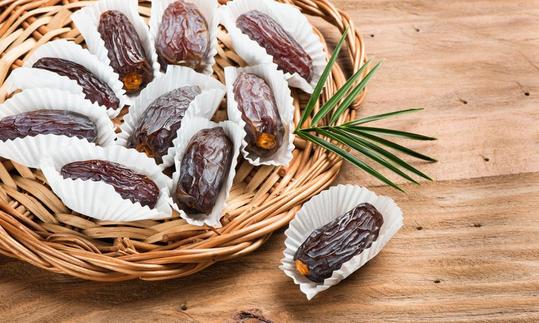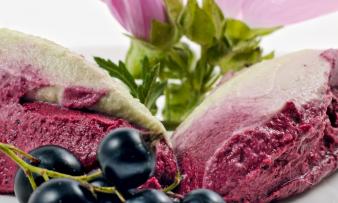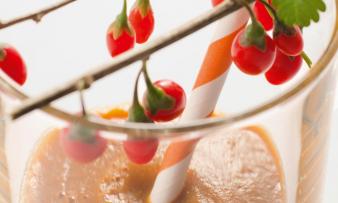Table of contents
When ripe , Medjool dates often have a softer consistency than other types of dates. Dried Medjool dates ( Phoenix dactylifera ) are very sweet. They are about three times as large as other types.
Use in the kitchen
Practically all dates outside the production areas are dried and are considered dried fruit. However, raw quality is rarely found, as they usually undergo a heating process (pasteurization) to ensure a longer shelf life. You can often buy pitted dates. Medjool dates are characterized by their size and their firm, juicy and thick flesh. The skin of Medjool dates is thin and fine, and the taste is reminiscent of caramel. They are softer and sweeter than Deglet Nour dates, for example.
Medjool dates are a delicious dessert on their own. The large dates are particularly suitable for filling with almonds , walnuts , pecans or marzipan. Filling with peanut butter or almond paste or as caramel pralines (yolos) is popular. The dates are occasionally glazed with sugar or covered in chocolate . However, this is not necessary as the dates themselves are very sweet.
Chopped dates are a great topping for muesli ( pea muesli ), salads or soups. If you mix dates, water and lemon , you get a delicious date syrup that you can use to sweeten all kinds of dishes.
Vegan recipe for Medjool dates stuffed with cashew cheese
Ingredients (for 4 people): 8 Medjool dates, 1 pinch of chili flakes , 2 sprigs of thyme , 100 g cashew cheese , 8 almonds .
Preparation: Mix the finely chopped thyme and chili flakes into the cashew cheese in a bowl. Cut the dates lengthways so that the halves still hold together and remove the pits. Fill the dates with the cashew cheese mixture. Use a piping bag or a small spoon to do this. Press an almond into each date and serve.
Vegan recipes with Medjool dates can be found under the note: " Recipes that have the most of this ingredient ".
| Not only vegans or vegetarians should read this: Vegans often eat unhealthily. Avoidable nutritional mistakes . |
Purchasing - Storage
Major retailers such as Coop , Migros , Denner , Volg , Spar , Aldi , Lidl , Rewe , Edeka , Hofer , Billa have a range of different types of dates, some of which are organic. Medjool dates are also usually available in health food stores and organic supermarkets such as Denn's Biomarkt and Alnatura . You can buy pitted dates and those with stones. When buying, make sure they are natural, organic if possible and without additives.
The main harvest time for Medjool dates is from October to January . That's why they are especially popular at Christmas time. Where can you buy fresh dates? Fresh dates that are of excellent quality can be ordered from specialised online shops. Wholesalers mostly sell bulk goods that can be stored for longer, especially out of season.
Are dates raw? If you care about raw food quality, you should buy dates in specialty stores or online and find out beforehand whether the product is really raw. Raw dates are gently dried and not treated. They are not pasteurized, gassed, frozen or treated with sugar, oil or flour dust. Any sulphurization is indicated on the packaging with the addition of either "E220" or "sulphurized".
The availability of Medjool dates varies depending on the size of the store, catchment area, etc. If you are interested, click on our recorded food prices for the DA-CH countries (above under the ingredient image). There you will find current prices from various supermarkets and their price development.
Storage tips
Medjool dates can be stored at room temperature if you eat them within 4-6 weeks. However, they can dry out slightly over time. If you want to keep the dates fresh, store them tightly sealed in the refrigerator. You can also freeze the dates in the freezer.
Ingredients - Nutritional values - Calories
Medjool dates (organic) contain 277 kcal. 100 g of dates consist of 75 g of carbohydrates, of which 66 g is sugar. This means that 100 g of dates cover 73.9% of the daily sugar intake, which is why dates should only be eaten in small quantities. But they also contain plenty of fiber. The 6.7 g/100g of dietary fiber corresponds to 26.8% of the daily fiber requirement. At 0.15 g/100g, they are almost fat-free. The protein content is also low at 1.8 g/100g. 1
Medjool dates contain a lot of potassium . They contain 696 mg per 100 g, which is 35% of the daily requirement. Bananas , which are often mentioned as a good source of potassium, contain 358 mg/100 g, which is 18.0% of the daily requirement. Dried porcini mushrooms contain a lot of potassium (2000 mg/100g). 1
They also contain small amounts of copper , manganese and magnesium , as well as small amounts of folate (folic acid) , phosphorus and calcium . 1
Dates contain few vitamins. They contain small amounts of vitamin B6 , pantothenic acid (vitamin B5) and niacin (vitamin B3) . Contrary to "advertising promises", they only contain traces of vitamin A and vitamin C. 1
The complete ingredients of Medjool dates, the coverage of the daily requirement and comparison values with other ingredients can be found in our nutrient tables below the ingredient image.
Health effects
Dates are rich in polyphenols, carotenoids, tannins, flavonoids and flavanols, which are known to be powerful antioxidants. Antioxidants reduce the risk of chronic diseases (e.g. cardiovascular disease, cancer and diabetes) and promote general health and well-being. 11 Numerous phenolic compounds such as polyphenols and flavonoids also have antibacterial effects due to their oxidizing potential 11,17 , which is why date syrup is used for colds, sore throats and coughs. 17
Fiber has a number of positive effects on our health and dates contain plenty of it (8.0 g/100g). 1 Fiber is responsible for a healthy digestive system 14 and reduces the blood sugar load when eating carbohydrates and starchy foods. In doing so, it reduces the risk of type 2 diabetes 15 . A diet rich in fiber leads to a feeling of satiety for longer, which can help with weight loss. 16
Dangers - Intolerances - Side effects
While there are many studies on the allergic potential of date pollen, those on the date fruit are still rare. Studies from Saudi Arabia show that date fruits can trigger allergic reactions. However, the test subjects did not react in the same way to every variety. 6,7
Dates are very high in sugar and the fructose content is very high. People with fructose intolerance or sensitivity should avoid dates. 13
In 2021, hepatitis A cases occurred in England, Wales and Australia due to the consumption of contaminated Medjool dates. 18,19
Folk medicine - natural medicine
Dates are traditionally administered to relieve fever, liver and abdominal pain, cystitis, gonorrhea and edema. Date syrup or paste is used for colds, sore throats and coughs. 10 They are also used for constipation, kidney stones, stomach and intestinal ulcers, postpartum bleeding, among other things. 11 Despite their widespread use, there is limited scientific and clinical evidence to support the above claims.
Ecological footprint - animal welfare
The ecological CO 2 footprint of dates depends on the country of origin, the corresponding transport and the method of consumption, but is roughly estimated at 0.6 kg CO 2 eq/kg. 21 Fresh dates, for example, require cooling during transport and are heavier - the amount of energy required and the amount of emissions produced are correspondingly higher. The main causes of emissions from date cultivation are pesticides, nitrogen fertilizers used and motor fuel. 20 However, date palms are particularly efficient at storing carbon, which in turn reduces their ecological footprint. 21
The amount of water required to produce 1 kg of dates is 2277 litres. 22 Since the main growing countries tend to be areas with little rainfall, this amount is considerable and artificial irrigation is sometimes used for irrigation. This also has a negative impact on the ecological footprint. Another major problem in date cultivation is the cultivation method - date palms often grow in monocultures, where they are susceptible to diseases and pests and synthetic pesticides and herbicides are used to prevent these. 21 In a study, measurements were taken of pesticide residues and heavy metal contamination in dates from Iran and found values that were far above the values classified as safe. 23 Ideally, when buying dates, you should buy organically grown goods.
Worldwide occurrence - cultivation
The date is one of the oldest known fruit crops. It has been cultivated in North Africa and the Middle East for at least 5000 years. Due to the long history of date cultivation and the wide distribution and exchange of date varieties, the exact origin (gene center) of the date is not clear. Date palms most likely originate from ancient Mesopotamia (Iraq, Syria) or the West Indies. 8
The Medjool or Madjhool or Medjoul variety (Arabic: مجدول) is the largest type of date. It originally comes from eastern Morocco. Today it is mainly cultivated in the USA (introduced as Madjool in 1927), Israel (as Mjhoul), Saudi Arabia, South Africa, Jordan and the Palestinian territories. The Medjool dates sold in Europe mostly come from Israel and some from the USA. 4
In international trade, no distinction is made between the individual date varieties. According to FAOSTAT , around 9.66 million tons of dates were grown worldwide in 2021. The main growing areas were Egypt (1.75 million tons), Saudi Arabia (1.57 million tons) and Iran (1.30 million tons). 2
Cultivation - Harvest
The real date palm can reach a height of 15 to 25 m. The date palm is dioecious, meaning that only female or male inflorescences appear per individual. A date plantation has an average economic lifespan of 40 to 50 years, but some date palms are productive for 150 years. Depending on the method of propagation, the young date palm needs 3 to 8 years before it bears its first fruit. 8
How do dates grow? Date palms are diploid (dioecious), meaning that each individual bears either male or female inflorescences. Fruits only come from pollinated female inflorescences. In commercial cultivation, only a few male palms are used so that their pollen can be collected and used for artificial pollination of the female date palms. Artificial pollination has been practiced in North Africa and the Middle East for thousands of years. This practice also saves a lot of valuable water. 5,8 Palm care and pollination, as well as fruit harvesting, usually take place at high altitudes. In some cases, fruit clusters are thinned out to increase fruit quality. Although climbing trees to access the crown is still common, the use of mechanical elevators is common in more advanced or industrialized production areas such as the United States. Date harvesting is still done by hand due to the lack of specialized harvesting machines. 8
Industrial production
After harvesting, damaged fruit is sorted out. The dates are washed and then dried with hot air. To remove the stones from the dates, the stem is cut off and the seed is pierced through the flesh with a wide needle. In industrial production, the majority of the products are then gassed and sterilized. Methyl bromide gas or, increasingly, gamma radiation is used for this. 12
Hydration or dehydration of the dates improves the quality of the fruit. The moisture content must be below 20% so that the dates can be stored without refrigeration. To do this, the fruit is heated to 60-70 °C. 9,12 The surface is sometimes treated with starch or oil to improve the texture. After pasteurization at 66 °C for 30 minutes, the dates are checked and packaged for shipping. Shipping usually takes place under refrigerated conditions. 9,12
Further information
The date palm ( Phoenix dactylifera ) is a plant species of the date palm genus ( Phoenix ) in the palm family (Arecaceae). Dates are known as the "bread of the desert" due to their high fiber content and are an important food in the growing areas. There are around 400 types of dates, of which over 100 are Arabian dates. 7 well-known types of dates are: Medjool, Deglet Nour , Khidri dates, Ajwa, Yahidi, Hallawi and Mazafati dates.
Alternative names
Medjool dates are also called the "queen of dates", not only because they are relatively expensive, but because of their taste. In English they are called Medjool dates or Madjhool or Madjool dates.











Comments